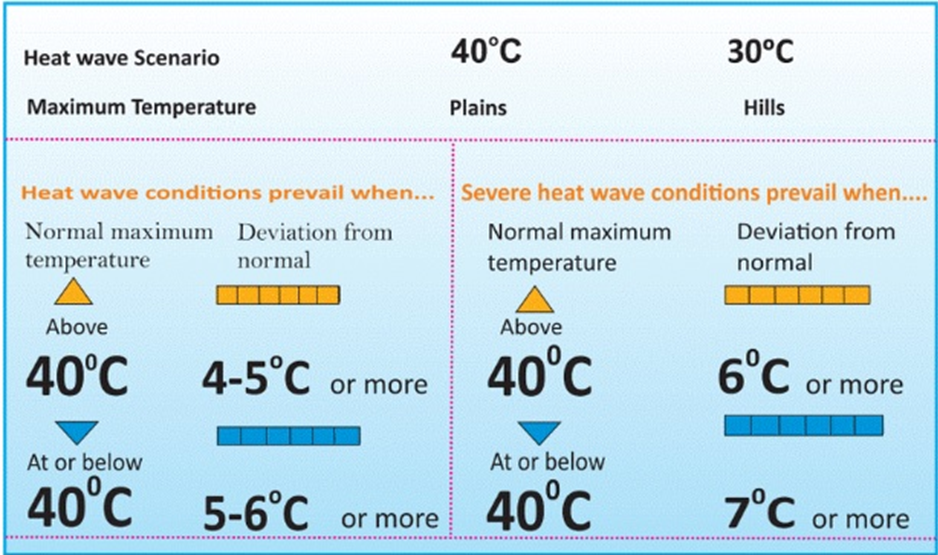BEAT THE HEAT WITH PEOPLE-CENTRIC RESPONSES
Why in the News?
- On March 15, 2025, several States and cities in India experienced the first severe heatwave of the year.
- This occurrence was 20 days earlier than the first severe heatwave in 2024, indicating a shift in seasonal patterns.
- The early onset suggests that India may be heading into another exceptionally warm year in 2025.
- This development highlights the urgent need for people-centric and multi-sectoral interventions to manage heat-related risks.
- There is also a growing necessity for science-based innovations to build resilience against rising temperatures.
Rising Heatwaves and Health Impacts
- Over the last decade, both the number of severe heat days and the intensity of heatwaves in India have been steadily increasing.
- The year 2024 was recorded as the warmest year on record globally, with temperatures averaging about 55°C above pre-industrial levels, according to the World Meteorological Organization (WMO).
- In India, December 2022 was the hottest December since systematic temperature monitoring began in 1901.
- The frequency of heatwaves in India has significantly risen in the last two decades, compared to the previous two.
- The combined effect of rising temperatures, humidity, and wind speed leads to heat stress.
- When external temperatures near the human body temperature (37°C), the body struggles to release internal heat generated through basal metabolism.
- This results in heat stress, which can impair the functioning of vital organs like the kidneys, liver, and brain.
- Severe heat stress can lead to illness and in extreme cases, even death.
Impact of Heatwaves
Socio-Economic Issues
- Heatwaves have wide-ranging impacts beyond health, affecting economic sectors and social equity.
- Rising temperatures contribute to agricultural distress, making it harder for farmers to work and reducing crop yields.
- Livestock deaths and reduced productivity are common during heatwaves, worsening the situation for farmers and the rural poor.
- Heat stress hampers outdoor labour, lowering farm productivity and workforce efficiency, particularly in agriculture and construction, which are labour-intensive sectors in India.
- Reduced working capacity due to extreme heat leads to loss of work hours, jobs, and consequently, household income.
- About 75% of India’s workforce (approximately 380 million people) are engaged in heat-exposed labour.
- Heat stress can cause an economic loss of 3% to 5% of GDP, as seen in India and other countries.
- In 2023, India reportedly lost nearly 6% of its total work hours due to heat stress.
- Rising electricity demand during heatwaves often leads to power cuts, affecting industrial output and productivity.
- The economic burden of heat stress impacts personal income and can slow national economic growth.
Equity Issues:
- The most vulnerable to heat stress include the poor, marginalised groups, migrants, subsistence workers, women, and the elderly.
- Women face added challenges due to social norms, such as indoor cooking in high heat, wearing culturally appropriate clothing, and limited access to cooler spaces for rest.
- This makes heat stress an issue of deep social and economic inequity.
Historical and Policy Context:
- As early as the mid-19th century, scientists noted that urban areas are hotter than rural ones, linking it to human-induced climate change.
- Despite this, it took nearly 150 years for the first Heat and Health Action Plans (HHAPs) to emerge — ironically in non-tropical regions of Europe between 2003 and 2008.
- In 2013, Ahmedabad, Gujarat, became the first Asian city to launch a Heat Action Plan (HAP).
- Over the past decade, more than 23 Indian States and around 140 cities have implemented State and city-level HAPs.
- India’s National Programme on Climate Change and Human Health (NPCCHH) works in tandem with the National Disaster Management Authority (NDMA) to provide heat advisories and health-related alerts.
Need for Heat Action Plans
Key Components of Most HAPs:
Typically, four to five core components make up most Heat Action Plans (HAPs):
- Early prediction of heatwaves to trigger timely alerts.
- Public awareness campaigns on preventive actions during heat events.
- Preparedness of the health system to manage heat-related illnesses.
- Long-term mitigation strategies, including:
- Increasing green cover (trees, parks).
- Keeping gardens accessible to the public.
- Promoting cool roofing methods, like painting rooftops white.
- Data collection and analysis of heat stress, morbidity, and mortality.
- Despite the formulation of HAPs in many Indian States and cities, implementation remains uneven and needs greater focus.
HAPs show partial success mainly in areas where:
- City authorities coordinate with State governments.
- Partnerships exist with public health institutions, NGOs, experts, and community-based organisations.
Learning and Action Points for 2025 and Beyond:
Strengthen and Localise HAPs
- Every State should develop or update its HAP based on best practices.
- Include humidity, not just temperature, in heat assessments.
- Design plans based on local vulnerability assessments.
- Clearly define the roles and responsibilities of stakeholders.
- Ensure activation by early March each year.
Improve Data Collection and Use
- Many cities in India face excess mortality due to heat stress, as noted in Preventive Medicine: Research & Reviews.
- Strengthen systems to collect and analyse heat-related data.
- Use existing data to identify:
- Who is most vulnerable (e.g., those suffering heat strokes).
- Which city areas are worst affected.
- Such insights can enable targeted, lifesaving interventions.
Upgrade Heat Warning Systems
- Learn from countries like the UK, which have Heat Health Alert (HHA) systems that factor in daytime and nighttime maximum temperatures.
- Indian HAPs should:
- Monitor both day and night temperatures.
- Use advanced forecasting tools to predict:
- Thermal comfort levels.
- Cooler time windows during the day for safe outdoor activity.
- Support continuity in school, office, and outdoor work schedules.
Strengthen Long-Term Preventive Measures
- Improve urban planning and infrastructure to reduce heat exposure.
- Promote heat-resilient building materials and construction practices.
- Recognise that heatwaves disproportionately affect the poor.
- Provide financial support or wage compensation to informal workers during extreme heat periods.
Tailor Advisories to Local Realities
- A 2022 study from India, Pakistan, and Bangladesh found that generic “stay indoors” advisories may not help poorer communities.
- In dense, poorly ventilated urban areas surrounded by high-rises, indoor temperatures can be higher than outdoors.
- Therefore, heat advisories should be:
- Geographically specific.
- Socially contextual, accounting for housing type and local infrastructure.
Promote Summer Shelters and Cool Roof Policies
- Indian cities should establish ‘summer or cold shelters’, similar to winter shelters, to offer relief during extreme heat.
- Some States have begun developing a ‘Cool Roof Policy’ to encourage the use of heat-reflective materials on building rooftops.
- Emphasis is needed on practical, science-based innovations for long-term heatwave prevention.
Enhance Basic Infrastructure and Workplace Flexibility
- During heatwaves, authorities often issue short-term health advisories, such as drinking water frequently.
- To support this:
- Municipalities must ensure access to drinking water through public water points.
- Availability of electrolyte solutions or ORS powder should be guaranteed.
- Workplaces (formal and informal) should:
- Allow staggered working hours.
- Encourage early morning or evening shifts.
- Close work during peak heat hours, especially for outdoor and informal workers.
Invest in Cost-Effective Adaptation Strategies
- Evidence shows that investments in heat adaptation are highly cost-effective.
- These can reduce:
- Health system burden (hospitals and emergency rooms).
- Broader social and economic costs of heat stress.
- Given the rising average temperatures in India and globally, there is a need for:
- Long-term, multi-sectoral strategies.
- Enhanced coordination among various agencies.
- Introduction of measures like insurance for wage losses due to heatwaves.
Adopt a People-Centric and Equity-Focused Approach
- Policymakers must recognise heatwaves as a social equity issue.
- The strategy must be people-centric, focusing on the needs of the most vulnerable.
- With this mindset, half the battle against heat stress can already be won.
Source:https://www.thehindu.com/opinion/lead/beat-the-heat-with-people-centric-responses/article69471759.ece
https://universalinstitutions.com/on-indias-heat-action-plans/
Mains Question (250 words):
Discuss the growing threat of heatwaves in India in the context of climate change. Evaluate the effectiveness of Heat Action Plans and suggest a people-centric and equitable approach to mitigation.




